Plant Tissue Study Guide
Introduction
Plant tissues are groups of cells that are similar in their origin and their structure and perform similar functions. They are a collection of similar cells that perform organized functions for their plants. They are specialized for a unique purpose, and they can be combined with other tissues creating organs like flowers, stems, leaves, roots, etc. There are also different types of tissues, including meristematic and permanent tissues, explained below.
What is Plant Tissue?
The word tissue comes from the French word ” tissue,” which means to weave. Plant tissue is a biological organizational level that transitions between cells and complex organs. They are clusters of cells that work together and attain specific functions. In plants, tissues can be classified broadly into 3 categories, they are:
-
Epidermal tissue: Cells that form the outer space of the plant leaves and the younger plants.
-
Ground tissues: These tissues manufacture nutrients by the process of photosynthesis and store reserve nutrients.
-
Vascular tissues: The prime components of this type are the xylem and phloem. These tissues transport the nutrients and fluids internally.
Types of Plant Tissue
Tissues can be divided into meristematic tissues and permanent tissues.
Meristematic Tissues
These tissues can divide and re-divide, forming new cells through the process of mitotic cell division. These newly formed cells will be similar to the parent cells, but they start to differentiate when they grow, and their characteristics keep changing. They assist in the major growth of the vegetation through growth in length and diameter.
The cells of meristematic tissues have a thin primary cell wall made up of cellulose. Each cell also has a dense cytoplasm and a nucleus with few vacuoles. They are generally oval, rectangular, or polygonal in shapes.
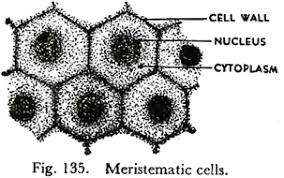
Meristematic tissues are generally cramped, and there are no intercellular spaces. Depending on where they occur, they are divided into:
-
Apical meristem: These occur at the growing tips and apicals of roots and stems. They raise the length of the plant.
-
Lateral meristem: These occur in the radial parts of the stems and roots. They increase the thickness of plants.
-
Intercalary meristem: They occur at the internodes and basis of leaves. They raise the size of the internode.
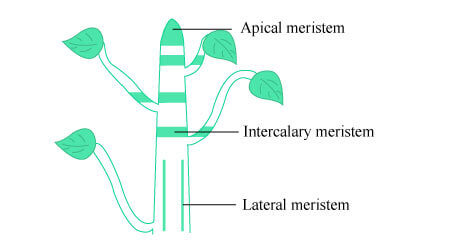
Permanent Tissues
These are a group of living or dead cells usually formed by the meristematic tissues. They generally lose their ability to divide, thus becoming permanent tissues. They are matured meristematic cells. As they have lost their ability to divide, they take up permanent shares, sizes, places, etc. This process of taking up the permanent shape, size, etc., is called cellular differentiation. There are two types of permanent tissues: simple permanent tissues and complex permanent tissues.
Simple Permanent TissuesThese tissues have groups of cells that are similar in function, structure, and origins. They are further classified into:
- Parenchyma: These tissues are composed of thin-walled cells having large vacuoles. The cells are loosely packed, and intercellular spaces are quite evident in these types of cells. They are generally isodiametric in shape. These tissues provide support to the plants and stores food. They are found in non-woody and soft parts of stems, roots, flowers, fruits, etc.
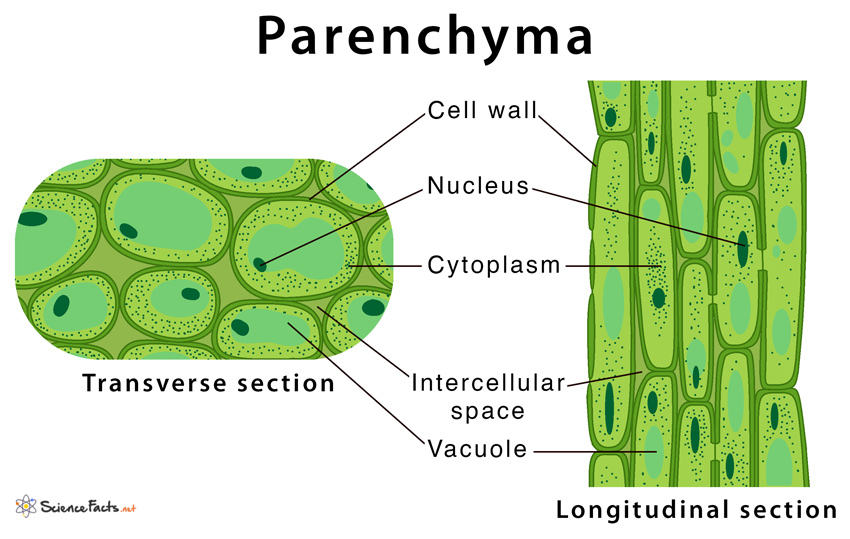
- Collenchyma: They are elongated living cells with minute little intercellular gaps. Their cell walls are made up of pectin and cellulose. They provide flexibility with structural frameworks and also mechanical support to the plants. They are found in the marginal sections of the stems and leaves.
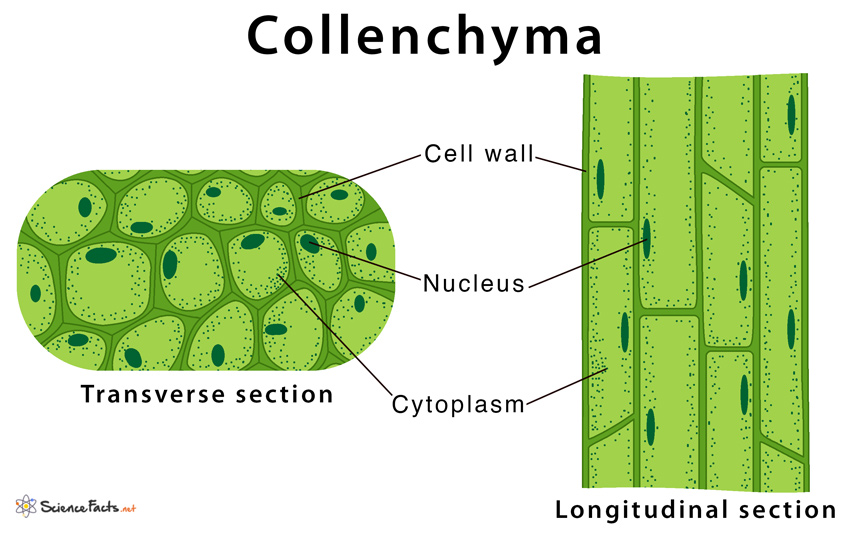
- Sclerenchyma: They are long, narrow, and thick-walled because of lignin deposition in their cell wall. They do not have any intercellular gap. Their main function is to provide strength to the plants. They are generally found in the veins of leaves, vascular tissues of stems, etc.

Complex Permanent Tissues These tissues are made up of more than one type of cell with a common origin and work together to perform similar functions. They help transport mineral nutrients, organic food material solutes, water, etc. Hence, they are also known as conducting and vascular tissues. These are divided into 2 types of tissues, they are:
- Xylem: This tissue helps to transport all dissolved substances and water throughout the plant. It is also called the chief conducting tissue. These tissues are organized in a tubular fashion throughout the main axis of stems and roots. The various components of the xylem included: vessels, tracheids, xylem fibers, parenchyma, etc. Most of the conduction here is vertical, but lateral conduction occurs through the rays, which are horizontal rows of long parenchyma cells.
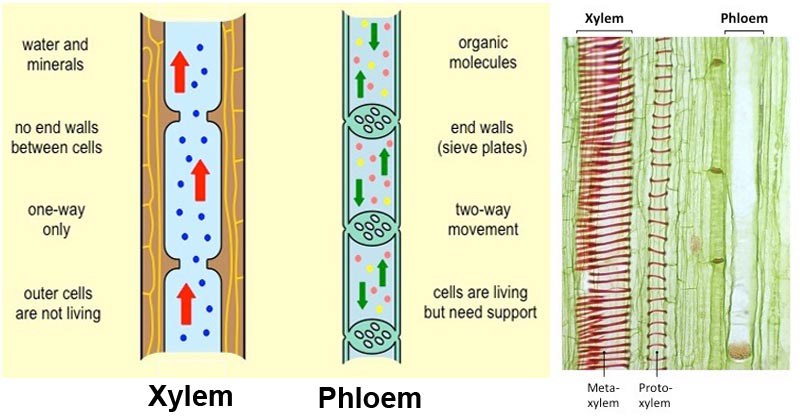
- Phloem: It is also called the plant’s plumbing system. They carry the dissolved food substances throughout the plant. The conduction system comprises sieve tubes, companion cells, and secondary walls. The various components of phloem included: sieve tubes, phloem fibers, companion cells, and phloem parenchyma.
Protective Tissues
The last type of plant tissue is protective tissues, and they provide support and fortification to plants. There are 2 types, cork and epidermis.
-
Cork: It is an external type of protective tissue. These cells are lifeless and lack intercellular gaps. The walls of the cells are coagulated with suberin. The main function of suberin is it makes the plant impervious to gas and other water molecules.
-
Epidermis: This is a cell made up of an outer casing throughout the structure of the plants. The stomata merge with this layer at certain places.
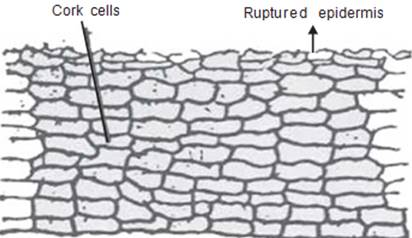
Functions of Plant Tissue
-
A tissue is a group of cells having a common origin and usually performing a common function. Plant tissues are classified into two main groups namely meristematic and permanent.
-
Growth in plants takes place by specialized regions of active cell division called meristems. Plants have different kinds of meristem. The meristems which occur at the tips of the roots and shoots are called apical meristems and these tissues help in elongation of stem and root.
-
Intercalorie meristems are present at the nodes of grasses and allow for rapid stem elongation.
-
Lateral meristems are found in all woody plants and in some herbaceous plants and they’re produced secondary tissues vascular cambium in stems and roots.
-
Permanent tissues do not generally divide further and it is of two types simple tissue and complex tissue. Simple tissue is made of only one type of cell and they are of three types parenchyma, collenchyma and sclerenchyma.
-
Parenchyma cells are generally isodiametric thin walled and of different shapes and they perform various functions like photosynthesis, storage and secretion.
-
The collenchyma occurs in layers below the epidermis in most of the dicotyledonous plants. The cells of collenchyma thicken at the corners due to deposition of cellulose hemicellulose and pectin. They provide mechanical support to the growing parts of the plants such as young stem and petiole of a leaf. Sometimes collenchyma contains chloroplast and they assimilate food.
-
Sclerenchyma contains long, narrow cells with thick and lignified cell walls and they provide mechanical support to different parts of plants.
Conclusion
-
Plant tissues are groups of cells that are similar in their origin, structure and perform similar functions.
-
They are a collection of similar cells that perform organized functions for their plants and are specialized for a unique purpose
-
Plant tissues can be classified broadly into 3 categories: Epidermal tissue, ground tissues, and vascular tissues.
-
Tissues can be categorized into meristematic tissues (can divide and redivide) and permanent tissues (cannot divide).
FAQs
1. What are the types of tissues in plants?
The types of tissues in plants are Meristematic tissues, Simple permanent tissues, Complex permanent tissues, and protective tissues.
2. What are the 3 types of simple permanent tissues?
They are Parenchyma, Collenchyma, and Sclerenchyma.
3. What is an example of plant tissue?
Epidermis tissue is an example of a plant tissue that covers the outer surface of the plant and controls exthe change of gases.
4. What are the 3 main types of tissues?
The 3 main types of tissues are Epidermal tissues, vascular tissues, and ground tissues.
5. What are the tissues in a leaf?
The 3 main tissues in leaves are epidermal, vascular tissues, and ground tissues.
We hope you enjoyed studying this lesson and learned something cool about Plant Tissue! Join our Discord community to get any questions you may have answered and to engage with other students just like you! Don’t forget to download our App to experience our fun, VR classrooms – we promise, it makes studying much more fun! 😎
]]>